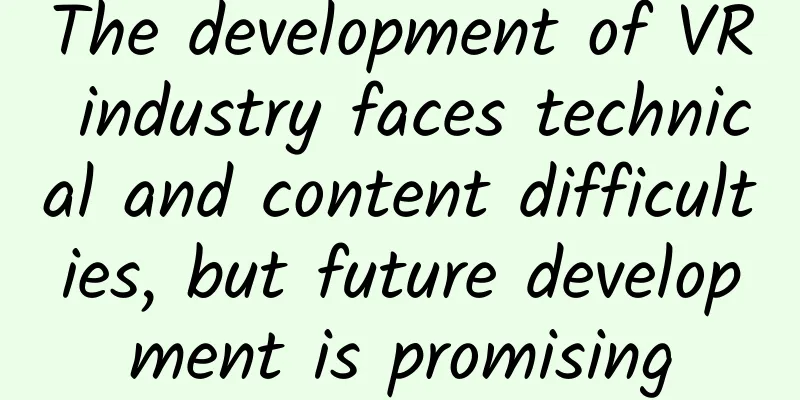The development of VR industry faces technical and content difficulties, but future development is promising

|
VR uses computer simulation to create a three-dimensional virtual world, providing users with simulations of vision, hearing, touch and other senses, allowing users to observe things in three-dimensional space in real time and without restrictions as if they were actually there. It gives people the feeling that there is no clear boundary between virtual and reality. Through some means, such as wearing VR equipment, users can feel like they are in a virtual world, including vision, hearing, and even extending to touch and smell.
VR Development History This was mentioned as early as the novel "Pygmalion's Spectacles" in 1935. In 1957, Morton Heilig invented the Sensorama and proposed the concept of VR. From the early exploration in the 1960s to the 1980s, from the explosion point and silence in the late 1980s to the early 1990s, it has now fully entered the public eye. From the essence of technological development, virtual reality has gone through four stages of evolution: the first stage is desktop virtual reality, which is related applications based on computer simulation and display; the second stage is immersive virtual reality, including head-mounted display and content consumption in virtual space; the third stage is augmented reality virtual reality. The use of head-mounted displays and related somatosensory devices gives virtual reality a preliminary interactive experience; the fourth stage is a distributed virtual reality system. All the previous virtual reality scenes are single-person and single-user virtual scenes. The goal of virtual reality is to connect people, so multi-user collaborative sharing of virtual reality is the future of virtual reality. Difficulties in the development of VR in my country In reality, the existing VR technology still mainly relies on the handle to select the interface and interact with it, and uses various sensors and mechanical devices to capture and identify human movements and collect human motion. However, this interactive method is difficult to give people a perfect experience and a high user penetration rate. Considering the launch of various VR devices and the gradual unification of VR content manufacturers, the interactivity of VR will become the core. However, each interaction method has its own advantages and disadvantages, and it is difficult to achieve unification in the short term. First, VR devices are different from mobile phones, PCs, etc. It is not yet a standardized interaction carrier, so it is difficult to standardize the interaction mode; secondly, VR is a three-dimensional world, which will inevitably increase the complexity and diversity of interaction. If you want to achieve immersion in the three-dimensional world, VR interaction should naturally include all the interaction methods in the real world. In addition to technical difficulties, my country's VR industry also has problems in content format. The current virtual reality industry focuses on game and application developers. For example, in the first 33 lists of HTC's virtual reality incubation project ViveX, content products account for less than 1/10, and panoramic videos and virtual reality video content, which are part of virtual reality consumer content, are ignored. Compared with the increasing number of game masterpieces, there are relatively few outstanding video content works. There are two reasons for this: first, the industry regards games as the key direction of educating users, and second, the cost of tools for producing content is too high, and related products and solutions are focused on the commercial market. As the third first year, 2016 is a year of rapid development of VR. my country's VR industry should seize this opportunity, innovate technology, improve the overall level of the VR industry, and go global. Although compared with the adoption process of smartphones and tablets, it is indeed difficult for VR basic equipment to reach the public in one or two years, but its huge development potential and far-reaching prospects have drawn a beautiful development blueprint. Let us wait and see. |
<<: Android 7.0 Nougat's five biggest flaws: no support for floating windows
>>: Summary: All the AR/VR/3D technologies and developments you should know
Recommend
Google Chrome browser has been warning frequently recently: What’s going on?
Recently, if you use Chrome browser to visit many...
Can a banana a day control blood pressure and reduce the risk of heart disease?
Bananas are a popular fruit with a sweet and smoo...
up to date! Data rankings of 59 information flow advertising platforms!
The following is the latest traffic ranking of 59...
How to keep your community active? Here are 2 tips to share with you!
Community activity is a difficult problem faced b...
The truth about the 6.18 promotion: users are anxious, and the conversion rate goes up
The truth about promotions is: when users are anx...
Uncover the 6 core skills of "social marketing"
If there is any low-cost and high-conversion oper...
How did Dacron, which was popular all over the country in the 1970s and 1980s, promote the "clothing revolution" among Chinese people?
I wonder how many people still remember "Dac...
Why is it so difficult to have children? Human evolution theory will give a reasonable answer
When we watch "Animal World", we often ...
Simulating a weightlessness experiment, lie in bed with your head down and your feet high for 90 days. How long can you last?
If you have to lie down for 24 hours a day, and k...
10 Misconceptions About Marketing Promotion!
In 2020, risks and opportunities coexist. From th...
WeChat JS-SDK Description (1)
Overview WeChat JS-SDK is a web development toolk...
More contagious! Where does the locally transmitted BA.5 variant come from?
In recent days, local epidemics have reappeared i...
China's smartphone shipments fell 6% in the second quarter, with Xiaomi's sales down 20% year-on-year
Market research company Canalys today released a ...
Why does WeChat limit the time to withdraw a message to 2 minutes? Can't we give it a few more minutes? The answer is not simple
[[418841]] As the ancients said, "Once a wor...
Big data interprets new trends in Apple App Store
This article mainly interprets the new trends of ...









